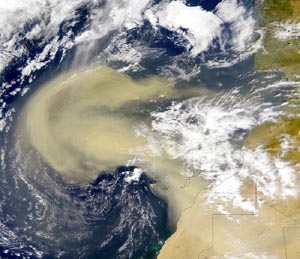| NOAA Magazine || NOAA Home Page |
NOAA RESEARCHER SAYS SAHARAN AIR LAYER CONNECTED TO ATLANTIC HURRICANE SUPPRESSION AND INTENSITY CHANGE
 April
12, 2004 — A NOAA researcher is
using NOAA satellite technology
to take a closer look at the effect African air may have on hurricanes,
especially how they develop and change intensity. Forecasting this change
would provide forecasters, emergency managers and citizens the information
they need to determine appropriate action before a storm makes landfall.
(Click NOAA satellite image for larger view of Saharan Air Layer
or SAL. Click here for high resolution version,
which is a large file. Please credit “NOAA.”)
April
12, 2004 — A NOAA researcher is
using NOAA satellite technology
to take a closer look at the effect African air may have on hurricanes,
especially how they develop and change intensity. Forecasting this change
would provide forecasters, emergency managers and citizens the information
they need to determine appropriate action before a storm makes landfall.
(Click NOAA satellite image for larger view of Saharan Air Layer
or SAL. Click here for high resolution version,
which is a large file. Please credit “NOAA.”)
Jason Dunion, a research meteorologist from the NOAA Cooperative Institute for Marine and Atmospheric Studies (CIMAS), working with the NOAA Hurricane Research Division in Miami, Fla., describes a new use of satellite technology to track and describe the role of the Saharan Air Layer (SAL) in Atlantic hurricane development and intensity change. Intensity change is an increase or decrease in wind speed consistently for at least one minute at an altitude of about 30 feet. Dunion’s work appears in the current (March) issue of the Bulletin of the American Meteorological Society.
The SAL is an elevated layer of hot, dry, dust-laden African air that often covers a large area of the tropical Atlantic during the hurricane season. The SAL has been investigated for several decades but its link to Atlantic hurricane activity had never been fully examined.
The SAL is not readily detectable with the individual visible and infrared (IR) sensors on most geostationary (GOES) and polar orbiting environmental satellites (POES). Dunion’s work discusses recently developed GOES split-window satellite imagery that permits continuous tracking of the SAL across the North Atlantic, Caribbean and Gulf of Mexico during the late spring through early fall, coincident with the Atlantic hurricane season (June 1 – Nov. 30).
“The SAL’s influence on hurricanes may be a factor in the challenge forecasters face in accurately predicting a tropical cyclone’s intensity in the Atlantic,” said Dunion. “It also may contribute to this basin’s relatively reduced level of hurricane activity compared to other ocean basins.”
The SAL is formed from a deep, well-mixed, dry (adiabatic) layer of air that forms over the Sahara Desert and Sahel regions of North Africa from late spring to early fall. As this air mass moves west and emerges from the northwest African coast, it is undercut by cool, moist low-level air and becomes the Saharan Air Layer. The SAL contains very dry air and substantial mineral dust lifted from the arid desert surface over North Africa and is often associated with a mid-level easterly jet stream.
Using Dunion’s multi-spectral GOES infrared satellite technique, forecasters can follow the progress of the SAL as it moves west over the tropical Atlantic. This imagery shows that when the SAL engulfs tropical waves, tropical disturbances or pre-existing hurricanes, its dry air, temperature inversion and strong vertical wind shear (associated with the mid-level easterly jet) can inhibit hurricane intensification.
“We are intrigued by this and other science that relates to the Saharan Air Layer and its potential to help advance our skill in forecasting tropical cyclone intensity,” said Max Mayfield, director of the NOAA National Hurricane Center.
The most efficient way to study and quantify the effects of the SAL’s dry air and strong mid-level jet is by first identifying it with the GOES SAL tracking imagery and then directing “hurricane hunter” aircraft to fly through it to determine its structure. The NOAA Gulfstream G-IV high-altitude hurricane surveillance aircraft releases instrument packages called Global Positioning System dropwindsondes in the area around the hurricane. Data collected in hurricanes from 1998-2001 have provided insight into the processes by which the SAL affects tropical disturbances.
The SAL was first described more than 30 years ago by Joseph Prospero, an atmospheric chemist at the University of Miami’s Rosenstiel School for Marine and Atmospheric Science and CIMAS director, and his colleague, Toby Carlson of Pennsylvania State University.
“The GOES technique developed by Jason Dunion will provide us with a much better picture of the impact of the SAL and African dust on the meteorology of the tropical Atlantic and Caribbean and its role in tropical storm development,” said Prospero.
CIMAS is a joint research institute between the University of Miami’s Rosenstiel School and the NOAA Atlantic Oceanographic and Meteorological Laboratory in Miami, Fla.
The American Meteorological Society is the nation’s leading professional society for scientists in the atmospheric and related sciences.
NOAA is dedicated to enhancing economic security and national safety through the prediction and research of weather and climate-related events and providing environmental stewardship of the nationís coastal and marine resources. NOAA is part of the U.S. Department of Commerce.
Relevant
Web Sites
NOAA Hurricane Research
Division
NOAA Saharan
Air Layer (SAL)
Media
Contact:
Jana Goldman, NOAA
Research, (301) 713-2483 or Erica
Rule, NOAA Hurricane Research
Division, (305) 361-4541